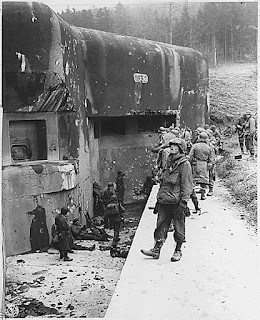Sutter’s Mill, where gold was first discovered in California in 1848, is one of the first historic places I remember visiting as an eager elementary school student. Colonial Williamsburg is another such location. In both places history surged to life. To walk among the stones and roads where history really occurred ignited something in me. It made history accessible.
 |
| Americans at the Maginot Line in 1944 Photo from http://media.nara.gov/media/images/11/31/11-3045a.gif |
That is one of the primary goals of historical fiction- making history touchable, alive, and vibrant (as I mentioned in Bringing Color to History).
The Maginot Line through the fields of Lorraine, in France, is another location where history sparked to life for me. The muskiness clung to my nose, the steps were steep, the lights were dim and history gripped me. Even my own eyes watered, not from the gases of a bygone era, but from the pollen-soaked fields surrounding me. Here, France struggled to maintain defensive control against a disconcerting neighbor who’d risen to aggression a handful of years before.
It is easy to think of the Maginot Line as a failure. It is presented as such. But, there’s another side to the Maginot Line. Although the defensive structure, the fortified walls and gun turrets failed to protect France during 1940, in 1944 the Allies were able to advance against Germany with aid of the Maginot Line.The weapons and stockpiles of the Maginot Line were put into action by the Allied troops in the Lorraine and Alsace to halt the German offensive of “Operation Nordwind” (North Wind) in December 1944 and primarily January 1945. In truth, even in 1940, there was nothing wrong with the Maginot Line. Its defenses didn’t break under Nazi bombardment. Instead, the aggressors employed a strategy that the French were not counting on. They surpassed the Maginot Line and advanced through the Ardennes Forest.
But, history is more than battles. It is more than defenses that failed or succeeded. Unlike the photographs we remember the events by, nothing is ever that black and white. To paint one group as defeated and another as victors minimizes the hurt and causalities that those who “won” returned with. Furthermore, it is too simplistic to determine that one group was bad. Were the Nazi atrocities horrible? Of course. But, not every soldier who wore that uniform followed that ideology. Some of the soldiers were not even German. Did you know, for example, that as the allies faced down the Nazis on the beaches of Normandy, some in the uniform were Russian or even Koreans, who’d been defeated by the Japanese and pressed into service?
To me, what matters is this- after a terrible nightmare of reality, freedom and liberty won. This came in many guises and means more than just the triumphant red, white and blue of French, American, and British flags flying alongside the Canadians and other allies. Some of the ways that freedom and liberty won include
1) The Nazis were stopped.
2) The majority of the world was free again- including the Germans who had also suffered.
3) Having faced such tragedy, advances were made to stop racism in the United States.
The Maginot Line, with its evocative meanings, deserves a second look. It is more than catastrophic defeat. Looking closer is demanded of something else as well: history.
My best to you all,
Megan
